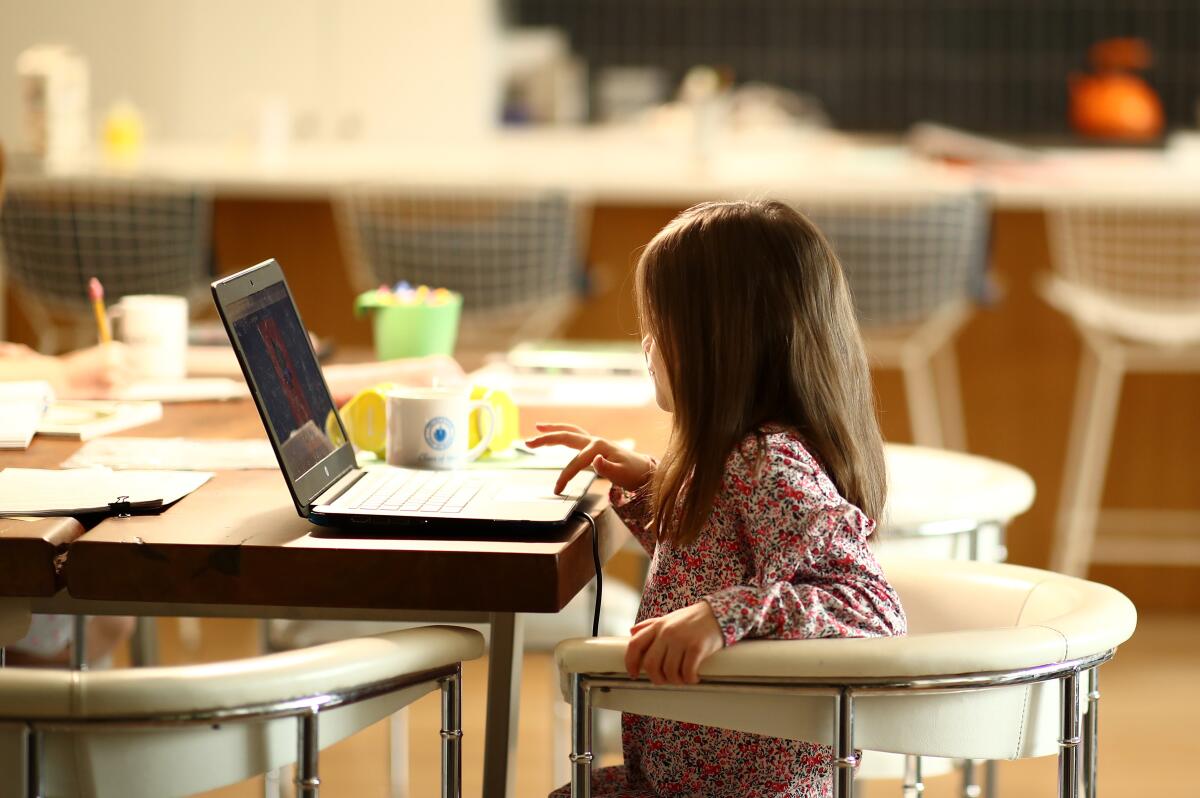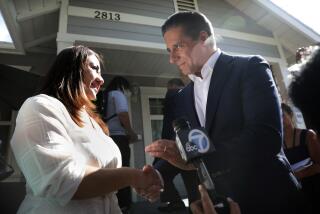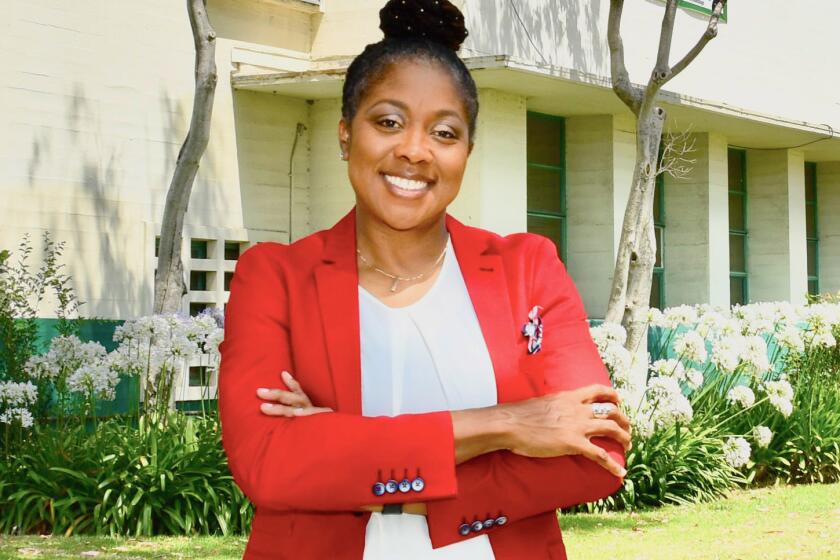Teachers find many obstacles as they try to keep kids learning amid coronavirus

Misti Kemmer, a fourth-grade teacher at Russell Elementary School in South Los Angeles, is working hard to keep her students learning now that schools are closed. She shares detailed lesson plans on Google Drive, sends messages to families every day and delivers YouTube lectures from her home.
But only three or four of her 28 students accessed their schoolwork last week, she said. Some don’t have computers and others are without internet access. One student can only open assignments on her father’s phone when he gets home from work.
“She’s trying to look at all this stuff on a tiny cellphone after dinner hours,” Kemmer said. “How much is a 9- year-old going to get done?”
“There’s this whole distance-learning thing, but how much learning is actually going on?” she added.
Almost all K-12 schools in California were shuttered last week. But from top state education leaders to district officials, including L.A. schools Supt. Austin Beutner, the message has been clear: Even though campuses are closed, learning will continue.
“While we are in very unique circumstances at this time, we are still providing education to our students,” state Supt. of Public Instruction Tony Thurmond said earlier this week. “School is not out, but we are finding a different way to deliver it.”
But the reality is complicated.
As teachers scramble to adjust to an entirely new world of education, they are coming up against significant barriers.
There is uneven access to technology, difficulties communicating with students and parents, and uncertainty about expectations at a time when many families are suffering.
And even for educators who have long used online learning tools and whose students have easy access to them, it is challenging to rely solely on technology.
Many teachers are grappling with this while also adapting to the tough realities of working from home.
At Marianna Avenue Elementary School in East Los Angeles, teachers and administrators scrambled after the closure was announced March 13 to make sure every student in first through sixth grades took home a Chromebook laptop, said Estela Campos, a coordinator at the school. The school is fortunate to have enough computers for nearly every student, she said.
But teachers are struggling to get their students online — some children had never used the computers at home and many families don’t have internet access. In some cases, children in higher grades are now having to take care of their younger siblings while their parents work and are unable to dedicate time to their own schoolwork, she said.
As Campos and others at the school try to resolve some of those issues, they’re also trying to find ways to keep students engaged and feeling a part of the school community. Starting Monday, teachers have planned for a virtual spirit week. There will be a nature day, a crazy sock day and others. They hope students will post photos to share with classmates.
But, she said, “we don’t know how many of the families we’re really reaching.”
“We’re just trying to do our best,” she said. “We’re at the point where we’re all learning.”
At Aspire Inskeep Academy, a K-6 charter school in South Los Angeles’ Florence neighborhood, teachers and administrators have a long list of things to do before they can even begin offering new lessons.
They have been reaching out to families to figure out who has computers or other mobile devices and internet access. Some families rely on public internet from the library or McDonald’s, but they can’t do that now with closures.
In the meantime, teachers have offered optional work packets to carry students through spring break, during the second week of April. The packets don’t contain new information, said sixth-grade humanities teacher Claudia Castillo.
“It’s to keep them engaged, it’s to keep them building on the skills that they’ve already learned,” she said.
Castillo and sixth-grade math teacher Erica Marquez together have 59 students. Of those, about 40 or their parents requested a packet, Castillo said.
On Monday teachers and administrators will start working on how to deliver new instruction, they said.
Erin Fitzgerald-Haddad, a seventh-grade math teacher at the San Fernando Institute of Applied Media, a Los Angeles Unified school, has the know-how and resources to make a transition to distance learning smoother.
Fitzgerald-Haddad said teachers and students at her school were regularly using digital platforms like Schoology, an LAUSD learning management system, or Google Suites long before the closures last week.
The school was able to send all students home with an iPad or Chromebook, though some opted out, and the school put together a YouTube channel where teachers have been posting daily videos. Faculty are also checking in with students and monitoring their work online, she said.
Even with their expertise to quickly mobilize resources, though, Fitzgerald-Haddad has noticed differences in how students are adapting to distance learning.
“Maybe it’s different at the high school level, but [for] eighth grade and younger, I do not believe it’s reasonable to expect students to be learning on their own,” she said.
While some students are advanced and will be able to pick up the material on their own, the Schoology platform allows her to see that some aren’t keeping up.
“The ones that really need the support, they’re the ones I’m having to make phone calls to,” she said.
Maria Arienza, a North Hollywood High School Spanish and creative writing teacher, said students at her school were given a mobile device to take home if needed.
But she said she’s received little direction from the district or her school’s administration on how to deliver instruction remotely. So she’s relied on coworkers to brainstorm ideas on how to plan online lessons.
Not all of her students have been in touch directly, but most are submitting assignments via Schoology, she said.
Despite some challenges, she said she still thinks the goals that school officials have set to continue learning going can be met.
“I believe that they are attainable, they’re not crazy expectations,” she said.
At Herrick Avenue Elementary in Sylmar, Jennifer Colvin teaches 23 children in transitional kindergarten and kindergarten. After the closure was announced, the little ones went home with paper packets, and students whose families said they didn’t have a device to connect to the internet at home received one from the school.
Since then, Colvin uses a messaging app to communicate with parents almost daily. She gave them all her cellphone number and access to her Facebook page and has repeatedly told them to reach out with any questions.
She also distributed a sample schedule and suggested students complete two pages of the packet a day, and she has recorded a video for the children almost every morning. She sees that around 17 parents a day watch the videos, but only five have communicated with her or asked questions.
“I have no idea what they’re doing,” Colvin said. “I don’t think they’re all even checking. I think some parents — maybe it’s just very overwhelming to them.”
Colvin is not assigning homework right now, and can’t say for sure that all of her students would have access to ClassDojo, the messaging app she uses, if she tried to assign work.
One parent in her class who speaks Spanish may not understand the video messages, she said. And while older students can use video conferencing to take classes, that’s not so easy for the the youngest of students, Colvin said.
“I’m setting up Zoom — but I’m like, really, am I really going to teach a lesson to these little kindergartners on Zoom?” Colvin said.
Asked if expectations from the state are meeting reality, she said: “I think they’re doing something. How do I know if it’s really learning that’s happening? I can’t prove that. I want to assume they’re doing what they’re supposed to do that would then assist in their learning.”
“It’s a hard place to be and we’re just trying to get through it,” she added.
Genaro Ulloa, a social science teacher Augustus F. Hawkins High School in South Los Angeles, said he was eager to connect with his students this week, but doing so wasn’t easy.
It took him a few days to get permission from school officials to use a messaging app to reach them. After getting the OK, he sent a message asking them to join a conference call Friday morning, using Schoology.
When students tried to join the call, some struggled to do so on their cellphones, which they rely on for internet access. So Ulloa asked them to switch to a video conferencing app. That worked, but by that point only eight out of 23 students were able to join.
Next Friday, Ulloa told his students, it will be mandatory for them to join the video conference. He asked them to share that message with their peers and he spent part of the day calling parents to figure out what they needed so his students can get online.
Despite the challenges, Ulloa said he wants to “find some sort of normalcy and expectations” for his students.
But, he added, “it’s been a struggle.”
More to Read
Sign up for Essential California
The most important California stories and recommendations in your inbox every morning.
You may occasionally receive promotional content from the Los Angeles Times.














